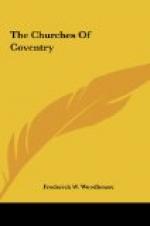There are but few landmarks in its history, and dates affecting the structure can generally be assigned by internal evidence alone. The nave arcades had already been rebuilt before the chancel was touched, and a piece of work of the same period is to be seen in the five-light Decorated window, in the Consistory Court which now opens into the large chamber over the porch. We have no record of the building of the clearstory and roof of the nave. The resemblances between this clear-story, and that of St. John’s chancel, raise the question of priority. The fuller development at St. John’s of the peculiar treatment of the angles points to its being a little later but probably both fall within the second and third quarters of the fifteenth century.
For a church of this size the chapels, altars and chantries were very numerous, there being probably fifteen altars in all. In 1522 the establishment of clergy consisted of a vicar, eleven parochial priests and two chantry priests. Dugdale enumerates six chantries so that it is evident that here as often elsewhere some of the parochial priests derived the whole or a part of their support from their performance of the duties of chantry priests.
Many chantry priests on the other hand had other duties and took part in other services than the daily mass for which the chantry was founded.
So much that is of interest in the religious life of the period is connected with the chantries that it is worth while recording some of the scattered notices that have come down to us.
To begin with the Chapel of Our Lady, the earliest mention we have of it is in 1364 while in 1392 the Corpus Christi Gild endowed a priest there to sing mass for the good estate of Richard II, Anne his queen, and the whole realm of England, to be called St. Mary’s priest. The indenture sets forth that “he is to be at Divine service on Sundays and double Feasts in the chancel and at Matins, Hours, Masses, Evensong, Compline and other offices used in the said church and also daily at Salve in our Lady’s Chapel unless hindered by reasonable cause.” The records of the Dissolution of the Chantries show how much town property must have been held by them, while from these and other sources we learn the extent of their belongings in tenements, messuages, rent charges and the like. Thus in 1454 Emot Dowte gave several tenements to this altar and in 1492 Richard Clyff “late parson of St. George in London,” left a house in Well St. to the church “to the intent that the mass of Our Lady may be observed the better.” In 1558 (the year of Elizabeth’s accession) William Hyndeman, alderman and butcher, directs that his body be buried in the Lady Chapel “as aldermen are wont to be buried, towards the charges whereof I give twenty nobles to be levied of my quick cattle and if it be too little then I will that Sybil my wife shall lay down 20_s_. more.” He also orders an obit to be kept after the death of his wife “yearly for ever;” a form of words that must surely have sounded unreal after the changes of the last two reigns.




